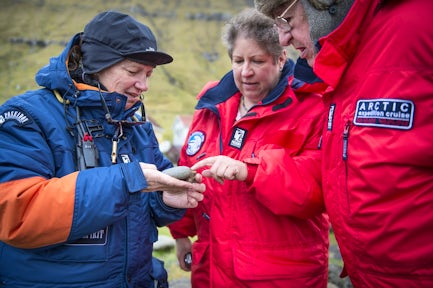Money
Currency while on land
The village of Ittoqqortoormiit, Greenland
Travelling to one of the most remote places on Earth requires a little bit of forward planning for cash withdrawals and budgeting. Your route will dictate what currency you'll need, and how much.
Major credit cards are widely accepted in every country in the main tourist areas and cities, and ATMs are prevalent in most major towns. However, make sure you stock up on cash before travelling to more remote areas.
Your card provider may charge you at a higher rate for making payments or withdrawals while abroad, so it may be worth checking these tariffs before you leave.
Depending on which countries you will be passing through, you will need different currencies:
- Norway - Krona (Norwegian)
- Denmark & Greenland - Krona (Danish)
- Finland - Euro
- Canada - Canadian dollar
- Russia - Rubles
- Iceland - Krona, however it is almost a cashless society. ATMs are available in towns and PINs are required for purchases.

Swoop says
To avoid any extra charges at ATMs, consider getting a currency card which you pre-load credit onto.
Budgeting & tipping
During a voyage
USD or Euros are accepted and you will have an onboard account which is settled at the end of the trip.
If you wish to tip your guides, $10-$20 USD per person per day on board is appreciated.
It's very much at your discretion, however, there are some very dedicated guides and other staff – such as chefs, waiters and waitresses, cleaners and receptionists – who really go the extra mile to make your trip as amazing as it can possibly be, and it's nice to reward them.
This is usually collected just prior to the end of the expedition and can be paid on a credit card. If you pay in cash, it’s very often

Specialist guides enhance your learning along the way
On land
Dining onboard
Travelling to the Arctic can be expensive. Expect to pay around $100-$150 USD per person per day for food, drink and transport. A further $150-$300 USD for fairly basic accommodation (and much more for luxury!).
Norwegian Arctic: Service charges and tips are included in restaurants and taxi fares, but if the service has been great 5% tips are generally appropriate.
Canada: Similar to the US. Generally, you can expect to tip around 15%-20% in restaurants and between 10% and 15% on taxi fares.
Greenland: Tipping is not expected, however, due to the scarcity of visitors and the opportunities to raise income it is especially appreciated if you have received great service in either a restaurant or from your guide.
Iceland: Service and VAT are always included in the prices so tipping isn’t required. Rounding up the bill or leaving a small tip for good service is appreciated but not expected.
Russia: It is customary to tip in restaurants and cafes, usually around 10%, but on other services it is optional.

